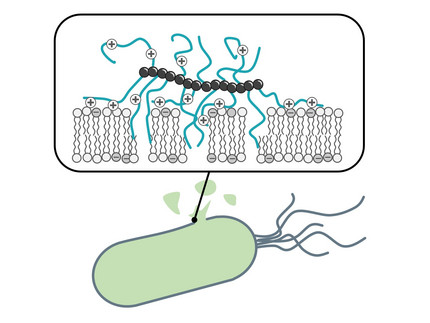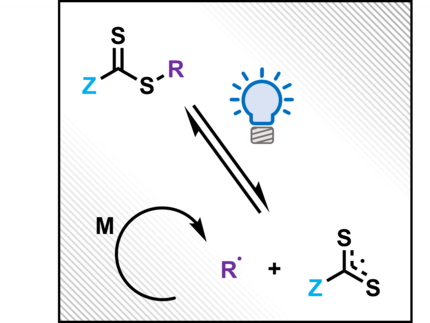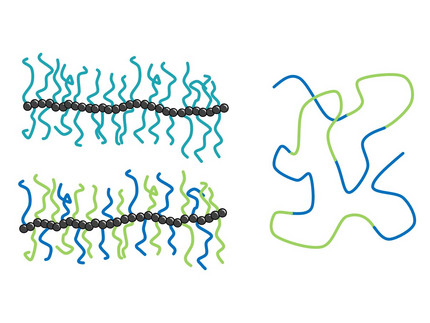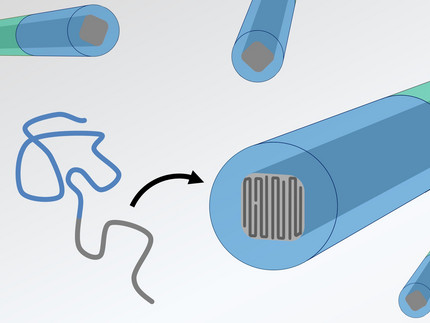Research Areas
Antimicrobial Polymers
Among the problems currently endangering our global public health, antimicrobial resistance (AMR) is one of the most serious issues. In a “post antibiotic era” a large share of medical progress achieved within the last 70 years would be jeopardized, leading to a significant death toll. To overcome this issue, new antimicrobial materials have to be developed, which are no affected by antimicrobial resistance. A unique feature of antimicrobial polymers is a low susceptibility for the development of new resistances, as they attack the bacterial membrane. This broad target cannot be altered easily by the microorganism and major changes in membrane structure would, in fact, also compromise the fitness of the microorganism.
Our current research is focused on implementing new features into antimicrobial polymers to increase their activity without compromising their selectivity for bacterial cells. Here, we probe different polymeric architectures such as multiblock copolymers or bottle brush copolymers to study the influence of parameters like multivalence and monomer segmentation on the biological activity.
Biomacromolecules, 2022, 23, 5350-5360.
ACS Appl. Mater. Interfaces 2020, DOI: 10.1021/acsami.0c05944.
Biomaterials, 2019, 217, 119249.
Photo-iniferter (PI)-RAFT Polymerization
Light-mediated polymerization techniques offer distinct advantages over polymerization reactions fueled by thermal energy, such as high spatial and temporal control as well as the possibility to work under mild reaction conditions. Reversible addition-fragmentation chain-transfer (RAFT) polymerization is a highly versatile radical polymerization method that can be utilized to control a variety of monomers and produce a vast number of complex macromolecular structures. The chain transfer agent (CTA), controlling a RAFT process can be activated directly via photolysis and forms a transient as well as a persistent radical. The former can initiate a drive polymerization, while the latter species is able to deactivate growing chains in a reversible fashion.
Consequently, PI-RAFT is characterized by a high livingness and is excellently suited for the production of complex macromolecular architecture such as multiblock copolymers. In our research we aim to develop the method further to make it faster, wider in scope and more robust toward various reaction conditions. PI-RAFT is further used as a tool to produce various macromolecular architectures for biomedical applications.
ChemRxiv,2022, DOI: 10.26434/chemrxiv-2022-tt8v7.
Macromol. Rapid Commun. 2021, 2100514.
Polym. Chem., 2022, 13, 1537 - 1546
Polymer Architectures
As polymer chemists we are highly interested in developing new ways of making functional polymeric materials. A particular interest lays on the impact of the polymeric architecture on the overall properties of the macromolecules and specifically on their bioactivity.
Here, we create for instance bottle brush copolymers, comp-copolymers, hyper branched copolymers, multiblock copolymers. RAFT polymerization is the main tool to achieve this structural versatility but also other methods, such as ROMP, or CROP are employed.
Polym. Chem., 2019,10, 1202-1212.
Chem. Comm., 2017, 53, 11901-11904.
ACS Appl. Mater. Interfaces, 2017, 9, 40117–40126.
Macromolecules, 2017, 50, 7380-7387.
Polym. Chem., 2017, 8, 4152-4161.
Macromolecules, 2016, 49, 8933–8942.
Supramolecular Polymers
In addition to conventional polymers we are also fascinated with non-covalent, supramolecular polymers, for instance build up by specific hydrogen bond interactions. These systems are highly interesting due to their dynamic nature mimicking natural protein fibers such as actin or tubulin. Without the adaptivity of these bio fibers, many cellular processes would be impossible and mimicking these system holds great promise for future generations of smart, dynamic materials.
We attempt to use the unique abilities of these materials for biomedical purposes such as antimicrobial systems. Here also the ability of supramolecular polymers to form long fibers with a high aspect ratio comes into play.
Polym. Chem., 2020, 11, 1083-1110
Chem. Sci. 2019, 10, 5476-5483.




